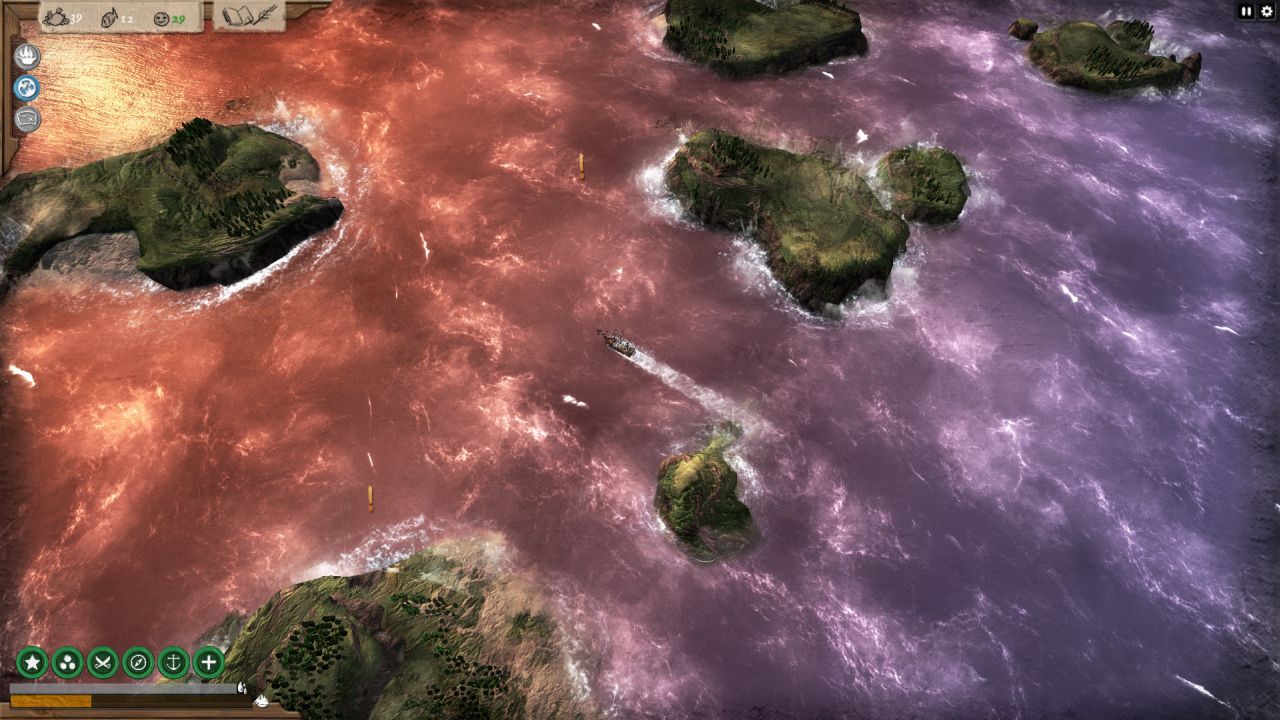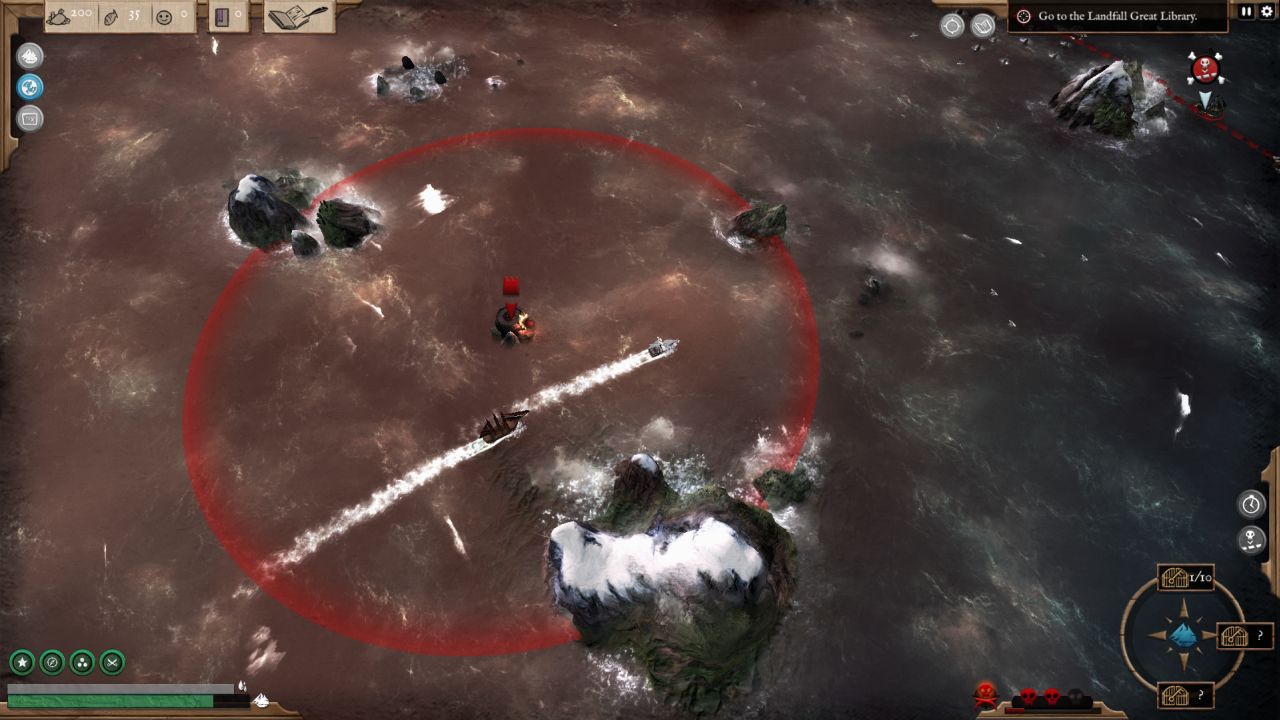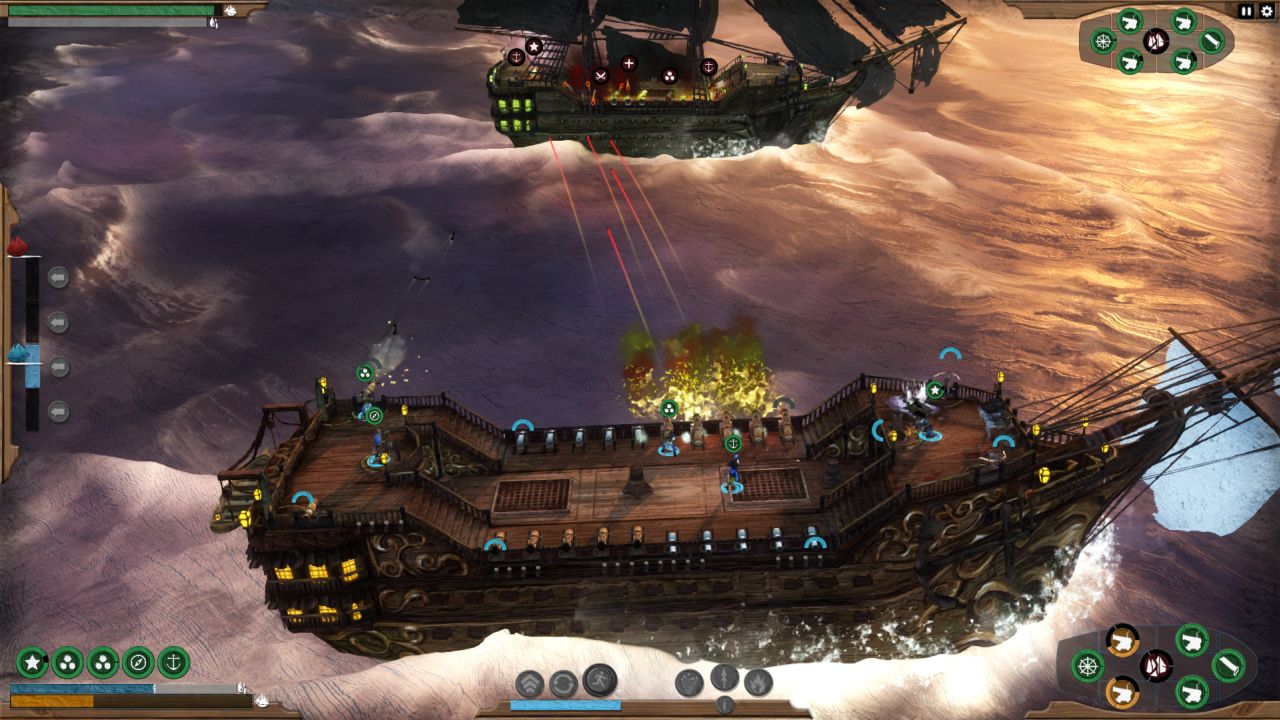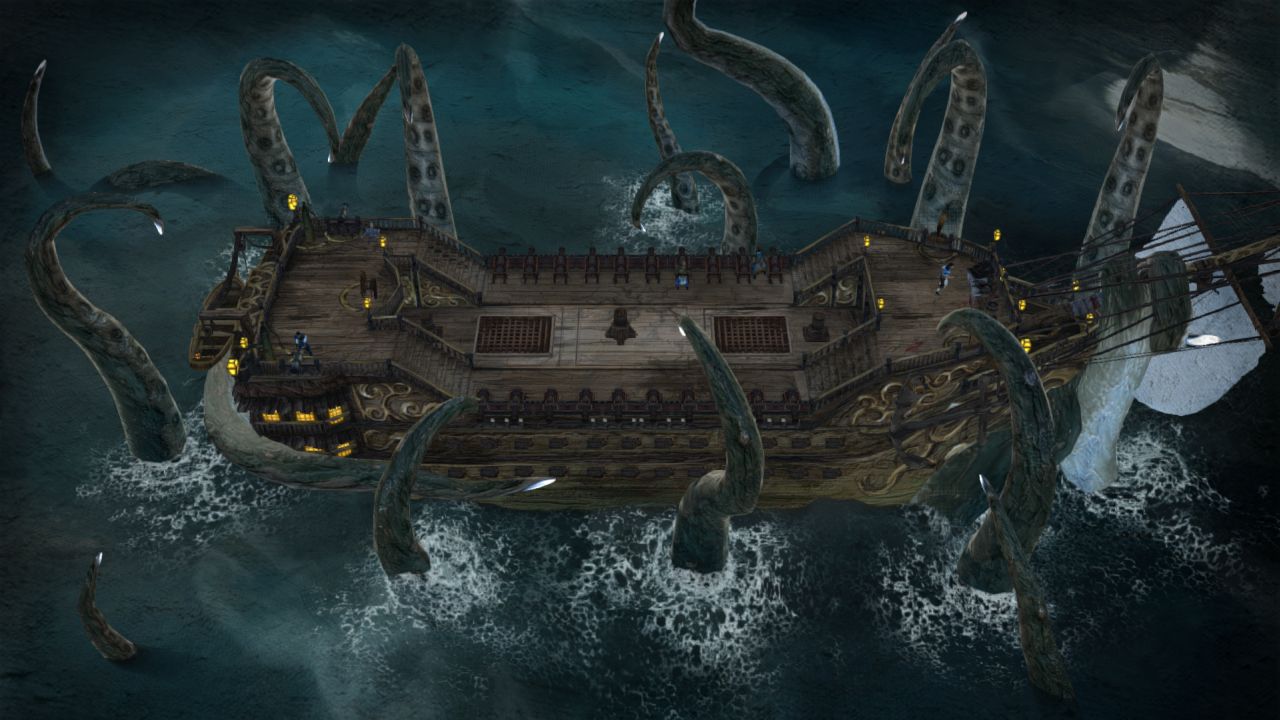Abandon Ship Review
Tales of Sails, Sea Monsters and Gunpowder
The Age of Sail, where sail-ships became the main means to discover and connect what was a relatively disjointed world, is a period often romanticised. The great freedom offered by the seven seas, the idealistic or unsavoury characters that roamed the waters and a style of warfare that took nerves of steel to partake in, make it an interesting period in which to set a game. Abandon Ship, Fireblade Software’s real-time naval strategy game, is set in such an era. It allows you to captain a vessel and its crewmen in very intense tactical battles on their journey to stop an ancient Lovecraftian evil which has been unleashed on the world. Though I did find certain unappealing or frustrating elements in the game (particularly among certain of its narrative, artistic and design choices), Abandon Ship in its whole kept me entertained and engaged throughout my playthrough.

You can choose one of five available campaigns, of which at least three I can tell you for sure are interconnected story-wise. The overarching story revolves around a cult unleashing a well-known sea monster (one popularly associated with a certain pirate franchise) upon the world. Each of the storylines - varying in length - sets the player in a well fleshed out scenario. All of the campaigns are introduced by a series of text screens and are accompanied by relevant art which depicts what is being told. These serve to outline your character's mission and motivations and aid the player’s overall immersion. All campaigns allow you to see the game’s world from different perspectives. Interestingly, for those less narratively inclined, the game offers a short Combat Campaign where you get experience the core gameplay of Abandon Ship (the naval engagements) in a more concise way. You’re faced with ten fights of increasing difficulty, where the only interjection is the occasional text screen which briefly explains who you are facing and why.
While playing, I found that the Lovecraftian narrative component of Abandon Ship (particularly the supernatural monster, which is the focus of the game) was thematically unappealing to me. It has been a bit overplayed in recent years and is very cliché when implemented in a story about the sea and ships. Now I do understand that some of H.P. Lovecraft’s characteristic story elements can be used to discuss important themes, yet in Abandon Ship they just took me out from a story which could have been very human and gritty.
Certainly worth complimenting is the world-building the developers implement through the longer campaign. As you play you will encounter several events and landmarks which give you greater detail of the seas you navigate and the game’s universe. Though they do occasionally fall back upon your classical fantasy tropes (i.e. fallen empires and the such), many of them I found quite creative and unique. A personal favourite of mine was a marker explaining the story of an enormous sea wall renamed “Joseph’s Debt” by locals. The wall’s massive cost ruined local state finances, resulted in tax spikes and culminated in popular revolt.Though what was built resulted in an impregnable defensive position, it was incomplete and could just be circumnavigated.

All campaigns, except the combat one, consist of a network of seas each representing a level. Each area - moulded like a nautical map of age-old - is made up of a large body of water which surrounds a number of islands. The player, represented by a tiny ship sprite, navigates these by holding down the left mouse button. The level then contains a number of markers representing potential battles, ports where you can refit your ship or hire new sailors and events which may affect your ship in a variety of ways (from losing much needed supplies to gaining positive traits on your crewmen). The connected seas are blocked by gates. To open these, you need to navigate to the various markers on your current map and complete the event attached until you fulfilled an established quota.
Sailing through the levels turned out to be quite tedious. Not because of the fog of war which hides all the markers once you reach a new area. This problem is fixed through the lighthouse marker - immediately revealed to the player once he reaches a new area - through which you instantly discover the entire level map. Rather, the dullness proceeds from the lifeless nature of the campaign map. The majority of times you move from marker A to marker B with little to nothing happening in the meantime. Only rarely are you presented with dynamic threats which actively pursue, forcing you to either manoeuvre around or confront them. And even so, a good chunk of these active threats are somewhat stationary. The hostile island forts simply protect an area around them and just cause small rates of hull damage until you leave their firing range. Meanwhile, faction ships, which move to engage your ship if in their patrol radius, guard such a small area that it makes them fundamentally static. Perhaps, this system would be more endurable if I could speed up time (like in Mount and Blade Warband) or perhaps chart an automatized itinerary by chaining movement orders when viewing the entire level’s map. But, alas, all you can do is hold/click your left mouse button to reach a destination in your ship’s immediate visual periphery.
I found as well that the game suffers a bit of an identity crisis. That is, it both wants to be a more user-friendly experience while also wanting to retain its original more ruthless nature, where risk or grind is rewarded but a single mistake will doom you. In trying to accommodate for both philosophies, the game introduces a series of conflicting mechanics that makes your voyage more relaxed at the expense of challenge. Take for example the tentacled horror released upon your ship if you stay too long on a single level. It will track you down and engage you in an arduous battle - one with the best and most scenic animations in the game - where fleeing is much more recommendable than fighting. This design, which creates a nice sense of urgency, is completely overridden by fleeing to a port once the beast is released. It will completely reset the monster’s timer, giving you much more time in a particular area. Take also the exploration bounty. Most levels have a port, and each port has an explorers’ guild which will reward the player with a progressively greater bounty if he explores more of the current map. This would be a very interesting value proposition given that it takes time to explore a map and the risks attached in staying too long in a single area. Yet by simply visiting the lighthouse marker, which instantly discovers the entire map for you, you’ll make a ton of gold with little to no effort.

The core gameplay of Abandon Ship centres around the many naval battles you’ll face throughout. The win/lose conditions are straightforward: destroy a ship’s hull integrity, sink it by cracking its deck, or murder its entire crew. To do so the game offers you quite a wide range of tools and weapons, some more realistic and others more absurd. From mortars which do less damage but set the ship ablaze (damaging the ship over time) to swivel guns which channel electricity and can chain-stun an entire crew (making them less able to respond to your boarding attempts or barrages), the game allows for various playstyles. There are also different types of purchasable ships that have ever greater hull strength, allow for more firepower and enable you to recruit a larger crew. These vessels however do not seem to have relative strengths and weaknesses that would encourage the use of different tactics. Rather they all seem to be straight up upgrades in health, damage, repair and reload speeds when compared to cheaper versions.
The engagements all take place in real-time but the game can be paused at the player’s pleasure. These occur essentially in a straight line as you cannot navigate freeform like you can in the campaign map. You and your enemy are locked on rails and forced to face a single side of each other’s ship. Though such a lack of manoeuvring could be considered a grave omission in a naval combat game (there is nothing more iconic to sea warfare than ‘crossing the T’), Abandon Ship does still manage to simulate tactical movement quite well. Through its ‘distance’ mechanic (i.e. four buttons you click that progressively move your ship closer or farther away from the enemy) or the abilities to ram/flip your ship, you are given the impression of using movement in order to maximize your ship's strengths or your enemy’s weaknesses. For example, take the ‘lobber’ weapon, which does massive damage when shot far away. With it, you keep yourself at the longest possible distance from the enemy while constantly peppering his sails with the chain shot (preventing him from closing the gap). Through these systems the game then maintains a satisfactory tactical depth necessary to its genre.
Virtually all actions in battle are linked to some sort of timer. Though you’d think that this would kill the pace of the game, especially given the absence of an active piloting component, the battles are actually quite frantic. From the second that the first barrage lands, your crew has to quickly repair the various sections of your ship (to maintain their efficiency), put out fires and repair holes. Although sometimes I wished there was some sort of macro-repair function - i.e. a ‘put out all fire’ button when selecting a crewman rather than individually right clicking every fire - this keeps you constantly on your feet and makes a hard fought victory much more rewarding. As well, once you get used to the various reload speeds and cooldowns, you can chain a series of actions together in a very satisfying manner. You can smoothly go from a long range barrage to quickly closing the distance with your enemy so to then initiate a ramming manoeuvre to deliver the killing blow. This fluidity is nothing but commendable.

The aforementioned conflicting philosophies are again evident in the game’s combat. The ability to pause in between battles, though preventing players from getting overwhelmed, does seem to defy that sort of brutal challenge that the game is going for. As well, increasing the difficulty or implementing Iron Captain, do not disable pausing. Similarly - even if a sunk enemy ship has heavily cracked your deck or started a fire which is now engulfing a big chunk of the ship - returning to the campaign map quickly fixes holes and puts out instantly the potentially fatal blaze. Though this saves the player from probably very dull microing, it undermines the hardcore experience the game also seeks to offer.
Abandon ship is a game which tries to cater to a wide range of audiences. At times, it does so effectively. For example, it offers a well-developed universe, but also offers more battle focused gameplay experience for those who just want action. However, at times, its apparent attempts to please everyone result in conflicting design choices. There is as well a fair share of less than optimal gameplay mechanics, like navigating through a campaign’s level, which becomes dull during longer gameplay sessions. Nonetheless, the battles consist of very intense engagements which flow very well. The game, through its five campaigns and a good variety in weapons, offers a worthwhile amount of content.
 Comments
Comments










